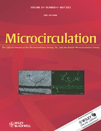
MICROCIRCULATION
Scope & Guideline
Transforming Understanding of Microcirculatory Processes
Introduction
Aims and Scopes
- Microvascular Physiology and Pathophysiology:
Research into the normal functioning of microvessels and how pathological conditions, such as diabetes, hypertension, and sepsis, disrupt these functions. - Techniques for Microcirculation Assessment:
Development and application of advanced imaging and analytical techniques, such as laser Doppler flowmetry and video capillaroscopy, to quantitatively assess microvascular dynamics. - Microvascular Responses to Pharmacological Agents:
Studies investigating how various drugs and compounds affect microvascular function, including vasodilators and antihyperglycemics. - Modeling and Simulation of Microcirculatory Dynamics:
Use of computational models to simulate microvascular blood flow and the effects of various physiological and pathological conditions. - Lymphatic Microcirculation:
Exploration of the lymphatic system's role in health and disease, including its involvement in immune responses and fluid balance. - Cellular and Molecular Mechanisms:
Investigation of the cellular interactions and molecular pathways that regulate microvascular function and their implications in disease states.
Trending and Emerging
- Microvascular Dysfunction in Systemic Diseases:
An increasing focus on how microvascular dysfunction is linked to systemic diseases, such as COVID-19, diabetes, and cardiovascular disorders, highlighting its role as a critical factor in overall health. - Advanced Imaging Techniques:
The adoption of cutting-edge imaging methodologies, including high-resolution imaging and computational modeling, to provide deeper insights into microvascular function and pathology. - Role of the Endothelium in Disease:
A heightened interest in understanding endothelial cell behavior and dysfunction in various diseases, particularly in relation to inflammation and oxidative stress. - Microvascular Responses to Metabolic Changes:
Research into how metabolic conditions, such as obesity and diabetes, affect microvascular function, reflecting a broader interest in the microvascular implications of metabolic syndrome. - Therapeutic Targeting of Microcirculation:
Emerging studies aimed at developing therapies that specifically target microvascular function, including pharmacological and bioengineering approaches.
Declining or Waning
- Traditional Angiogenesis Studies:
Research focused on classic angiogenesis mechanisms appears to be less prevalent, possibly due to the rise of more nuanced understandings of microvascular dynamics and the complexity of vascular biology. - Basic Histological Studies:
The emphasis on purely histological characterization of microvessels has diminished, likely replaced by more integrative approaches that combine histology with functional assessments. - Single-Condition Studies:
Research focusing on microcirculation in isolation, without considering systemic interactions or multi-organ perspectives, is becoming less common as integrative approaches gain traction.
Similar Journals

JOURNAL OF MUSCLE RESEARCH AND CELL MOTILITY
Exploring the Interplay Between Cells and Muscle MechanicsJOURNAL OF MUSCLE RESEARCH AND CELL MOTILITY, published by Springer, is a premier journal dedicated to advancing our understanding of muscle biology and cellular motility. With an ISSN of 0142-4319 and an E-ISSN of 1573-2657, this journal stands out in the fields of biochemistry, cell biology, and physiology, proudly holding a Q2 ranking in each of these categories as per 2023 metrics. Covering significant developments from its inception in 1963 to its anticipated contributions through 2024, this journal serves as a vital platform for researchers and professionals to disseminate their findings and insights globally. Although it does not currently offer open access, its robust academic rigor and relevance are evident from its Scopus rankings, making it a crucial resource for those invested in the biological sciences. With a focus on original research articles, reviews, and methodological advancements, the journal fosters innovative collaborations and discussions within the scientific community, making it an invaluable addition to any researcher’s library.

BIOLOGY OF THE CELL
Fostering dialogue in the dynamic field of cell biology.BIOLOGY OF THE CELL is a prominent academic journal published by Wiley, dedicated to advancing the field of cellular biology through the dissemination of innovative research and insights. With its ISSN (0248-4900) and E-ISSN (1768-322X), this journal has been a vital resource since its inception in 1981 and is set to continue its scholarly contributions until 2024. Positioned within the Q3 quartile in Cell Biology and Q2 in Medicine (miscellaneous) as of 2023, BIOLOGY OF THE CELL is recognized for its rigorous peer-review process and its commitment to high-quality publication in critical areas such as biochemistry, genetics, and molecular biology. Although the journal does not currently offer open access options, it remains accessible through the Wiley platform, ensuring that researchers, professionals, and students can benefit from its rich repository of knowledge. By linking fundamental cellular processes with broader medical implications, this journal serves as a critical platform for fostering dialogue and innovation in cellular research, making it an essential read for anyone engaged in the life sciences.

Doklady Biochemistry and Biophysics
Connecting Researchers through Innovative Biochemistry and Biophysics InsightsDoklady Biochemistry and Biophysics is a vital resource for the advancement of knowledge in the fields of biochemistry and biophysics, published by MAIK NAUKA/INTERPERIODICA/SPRINGER. Featuring an ISSN of 1607-6729 and an E-ISSN of 1608-3091, this journal plays a critical role in disseminating research findings and fostering scholarly discourse. Despite its recent ranking in the Q4 quartile for biochemistry and biophysics in 2023, it serves as an essential platform for researchers exploring these intertwined disciplines. The journal’s scope encompasses a wide variety of topics, enhancing the understanding of biochemical processes and physical principles in biological systems. With converged years of publication from 2001 to 2024, it stands as a continual source of knowledge for its readers, who include researchers, professionals, and students alike. While the journal currently does not offer open access options, its contributions remain significant within the scholarly community, illustrated by its competitive Scopus rankings across related fields.

Diabetes & Vascular Disease Research
Empowering researchers to combat vascular complications of diabetes.Diabetes & Vascular Disease Research is a leading academic journal dedicated to advancing the understanding and treatment of cardiovascular and metabolic diseases, particularly diabetes. Published by SAGE Publications Ltd in the United Kingdom, this journal serves as a key resource for researchers, clinicians, and students seeking to explore the intricate relationship between diabetes and vascular health. With an impressive Impact Factor and ranked in the Q2 quartile in prominent categories such as Cardiology, Endocrinology, and Internal Medicine, the journal provides a platform for high-quality, peer-reviewed research. Covering a broad range of topics from pathophysiology to therapeutic innovations, Diabetes & Vascular Disease Research plays a vital role in shaping contemporary discourse in the field. With contributions from leading experts and a commitment to disseminating valuable findings, this journal is a must-read for anyone involved in the fight against vascular complications arising from diabetes.

HISTOCHEMISTRY AND CELL BIOLOGY
Illuminating the Intricacies of HistochemistryHISTOCHEMISTRY AND CELL BIOLOGY, published by SPRINGER, is a prominent journal dedicated to advancing the fields of histochemistry and cell biology. With an ISSN of 0948-6143 and an E-ISSN of 1432-119X, this journal has carved a significant niche since its inception in 1995, striving for excellence in research dissemination through a rigorous peer-review process. The journal's impact is reflected in its strong performance across various academic categories, achieving a Q1 ranking in Medical Laboratory Technology, Q2 in Histology, and maintaining a credible presence in Cell and Molecular Biology. Nestled in Germany, and with the backing of a reputable publisher, HISTOCHEMISTRY AND CELL BIOLOGY serves as a pivotal platform for researchers, professionals, and students, fostering innovations that push the boundaries of our understanding of cellular processes. While the journal is not open access, it offers subscription-based access options ensuring comprehensive coverage of crucial findings in the rapidly evolving arena of cell biology and histochemistry.

Biochemistry Moscow Supplement Series A-Membrane and Cell Biology
Exploring the Frontiers of Membrane DynamicsBiochemistry Moscow Supplement Series A-Membrane and Cell Biology, published by PLEIADES PUBLISHING INC in the United States, is a pivotal journal in the fields of biochemistry, biophysics, and cell biology. Established in 2008, this journal has become a significant platform for disseminating novel research findings and reviews, fostering advanced studies in membrane dynamics and cellular processes. Although currently ranked in the Q4 quartile across its categories, the journal provides researchers and professionals with open access to a wealth of knowledge, helping to bridge gaps in understanding complex biochemical mechanisms. The journal’s commitment to quality and relevance is evident as it continues to contribute to the academic community through its coverage of innovative and emerging topics in cell and membrane biology. Researchers, practitioners, and students alike will find this resource invaluable for keeping abreast of the latest developments in the ever-evolving landscape of biochemistry and cellular research.

Current Opinion in Physiology
Connecting Researchers to the Pulse of PhysiologyCurrent Opinion in Physiology, published by Elsevier, is a leading journal dedicated to the dynamic field of physiology. With an E-ISSN of 2468-8673, this journal provides a platform for the latest insights and perspectives, reflecting the evolving landscape of physiological research. Operating from the United Kingdom, the journal holds a respectable impact factor and is ranked Q2 in both general physiology and medical physiology categories, highlighting its prominence among the global academic community. With Scopus rankings placing it in the 64th and 60th percentiles within its respective categories, Current Opinion in Physiology serves as an essential resource for researchers, professionals, and students eager to stay informed about innovative theories and emerging trends in physiology. The publication emphasizes high-quality reviews that summarize current knowledge and future directions, ensuring readers gain valuable insights applicable in both clinical and research settings.

KOREAN JOURNAL OF PHYSIOLOGY & PHARMACOLOGY
Exploring the frontiers of physiological research since 1997.Welcome to the Korean Journal of Physiology & Pharmacology, a pivotal academic platform dedicated to advancing the disciplines of physiology and pharmacology. Published by the esteemed Korean Journal of Physiology & Pharmacology, this journal has been disseminating valuable research findings since its inception in 1997 and continues to be a critical resource for researchers, professionals, and students in South Korea and beyond. With an ISSN of 1226-4512 and E-ISSN of 2093-3827, it offers insights into various aspects of drug action and physiological mechanisms. Although this journal currently does not subscribe to Open Access, it plays a vital role in bridging the gap between experimental and clinical studies, receiving commendations for its quality. In the 2023 Scopus rankings, it is notably positioned in the Q3 quartile for Pharmacology and Q4 for Physiology, reflecting its commitment to excellence. As the journal converges towards its comprehensive coverage in 2024, it remains a cornerstone for those looking to engage deeply with critical developments in these fields.

Molecular Brain
Exploring the Intricacies of Cellular and Molecular NeuroscienceMolecular Brain is a prestigious open-access journal published by BMC, dedicated to advancing the field of neuroscience with a particular focus on cellular and molecular mechanisms. Since its inception in 2008, the journal has been committed to disseminating high-quality research that explores the intricate workings of the brain, particularly in areas related to cellular and molecular neuroscience. Located in the heart of London, England, Molecular Brain has garnered significant recognition in the academic community, boasting a 2023 categorization in the Q2 quartile for both Cellular and Molecular Neuroscience and Molecular Biology, reflecting its growing influence and relevance in these fields. With its Scopus ranks placing it in the top 32% and 38% of its respective categories, the journal serves as an essential platform for researchers, professionals, and students alike, encouraging collaboration and knowledge-sharing through its accessible online format.

GENERAL PHYSIOLOGY AND BIOPHYSICS
Empowering Scholars in the Study of Life's DynamicsGENERAL PHYSIOLOGY AND BIOPHYSICS, published by AEPRESS SRO, is a pivotal journal in the fields of biophysics and physiology, dedicated to advancing knowledge and fostering research in these increasingly vital disciplines. Established in 1983 and set to converge in 2024, the journal provides a platform for scholarly articles that explore the intricate relationships between biological systems and physical principles. Its current category quartiles include Q3 in Biophysics and Q4 in Physiology, demonstrating a growing influence among researchers, with current Scopus ranks reflecting its commitment to quality and relevance. Despite not being an open-access publication, the journal remains a valuable resource for professionals and students aiming to stay informed on the latest discoveries and methodologies. By supporting interdisciplinary research and innovation, GENERAL PHYSIOLOGY AND BIOPHYSICS plays a crucial role in shaping the understanding of complex biological interactions and applications in medicine.